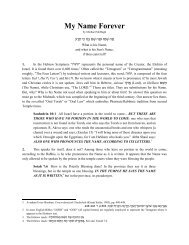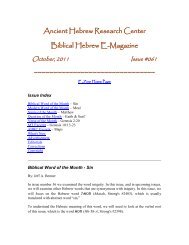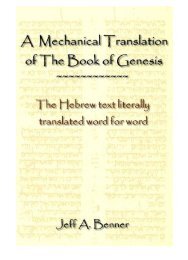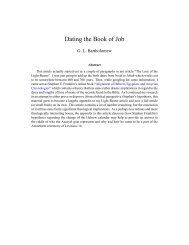Ancient Hebrew Language and Alphabet
Ancient Hebrew Language and Alphabet
Ancient Hebrew Language and Alphabet
You also want an ePaper? Increase the reach of your titles
YUMPU automatically turns print PDFs into web optimized ePapers that Google loves.
Appendix A – <strong>Alphabet</strong> Reconstruction<br />
four vertical lines being the poles. All the letters from<br />
3,000 BCE to the present day in the <strong>Hebrew</strong>, Arabic<br />
Greek <strong>and</strong> their sister cultures have used a derivative of<br />
the third pictograph, the tent wall.<br />
Mnemonic (meaning): Outside, Inside -- the function of<br />
the wall is to separate these two; Half -- a dividing into<br />
two parts; Secular -- what is outside; Arrow, Slingstone --<br />
from their dividing of flesh<br />
Syllabic (name): The Modern <strong>Hebrew</strong> name is tx / chet,<br />
meaning a string. A very similar word is #x / hhets,<br />
meaning a wall, most likely the original name for this<br />
letter.<br />
Phonetic (sound): The original sound for this letter is<br />
probably a guttural "hh" (as in the name Bach <strong>and</strong> the<br />
German word ich), as in Modern <strong>Hebrew</strong> <strong>and</strong> Arabic.<br />
Thet<br />
Picture: The oldest form of the original pictograph is ,<br />
apparently a type of basket or container.<br />
Mnemonic (meaning): Store, Contain -- baskets were<br />
used for storing foods, supplies <strong>and</strong> other necessities of<br />
the nomadic life; Mud, Clay -- a material for making<br />
baskets <strong>and</strong> other containers.<br />
Syllabic (name): Modern <strong>Hebrew</strong> has retained the<br />
original two letter word jj / tet, meaning mud or clay, for<br />
the name of this letter.<br />
59






